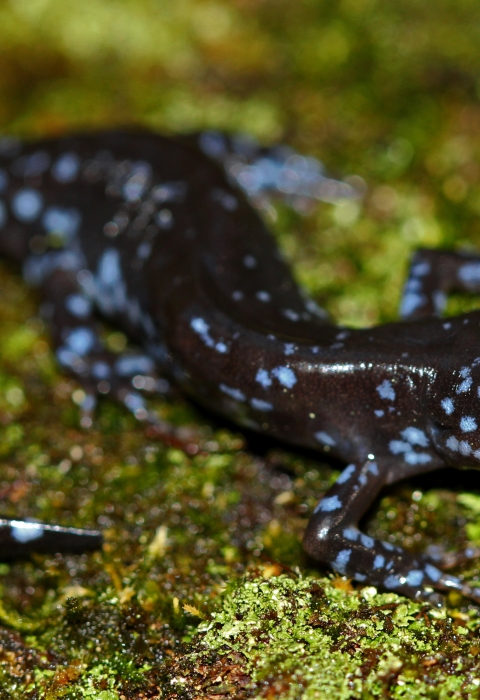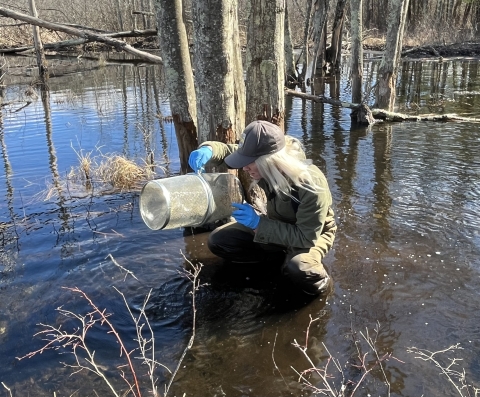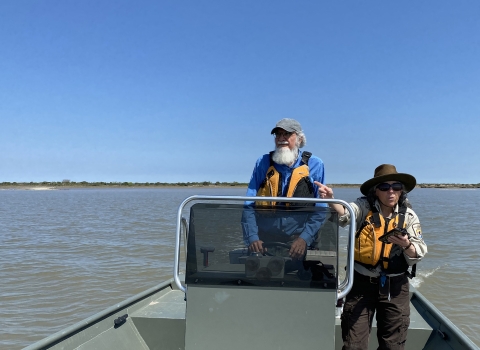It rained overnight in Massachusetts on April 17, 1775, and continued into the following day. But the skies had cleared by the time Paul Revere set off on his late-night ride from Boston to Lexington to sound the alarm that the British were coming.
When British soldiers, known as Red Coats, reached the Lexington town green early on the morning of April 19, a militia company led by Captain John Parker was waiting for them. A stray shot led to a round of fire from the British, resulting in eight dead and ten wounded among the colonists.
The British continued marching west as intended, to destroy stores of ammunition in Concord, but on their return, they met resistance from locals who knew the lay of the land. Captain Parker got his revenge at the border of Lexington and Lincoln, launching an attack from high ground on the property of Tabitha Nelson.
Salamander eggs and musket balls
Meanwhile, at a low point on the east side of the property, groundwater seeped onto the forest floor. It may have been wetter from the recent rain, but there was probably no standing water.
250 years later, that seep has evolved into a seasonal wetland, or vernal pool — the result of 20th-century activities that compacted the soil and raised the groundwater level, according to a study on historical landscape change.
Today on rainy, April nights, salamanders emerge from the leaf litter in the surrounding woodlands and converge on the pool to wait for mates.
In 2022, biologists found evidence of the rare blue-spotted salamander in the vernal pool— just a few years after archaeologists determined the “Parker’s Revenge” battle had taken place about 100 yards away. Both investigations uncovered small, round clues: salamander eggs and musket balls.
We know about the skirmish and the salamanders because, while the Nelson house is gone, the vernal pool has attentive new neighbors: Minute Man National Park to the south and Hanscom Air Force Base to the north.
Now, in partnership with the U.S. Fish and Wildlife Service, Hanscom is trying to figure out where else on base the blue-spotted salamander may occur.
Win-wins for conservation and defense
Recognizing that military lands contain some of the nation’s most valuable natural assets, Congress passed the Sikes Act in 1960 to protect them. The act requires Department of Defense installations with significant natural resources to develop Integrated Natural Resources Management Plans in coordination with applicable state wildlife agencies and the U.S. Fish and Wildlife Service.
Just as important, installations need to monitor outcomes from these plans to ensure they’re meeting conservation targets without compromising military readiness.
More often than not, conservation is a win-win.
Scott Sheehan, Hanscom’s natural resources program manager, explained that in general, strategic natural resource management — like controlling invasive species invasive species
An invasive species is any plant or animal that has spread or been introduced into a new area where they are, or could, cause harm to the environment, economy, or human, animal, or plant health. Their unwelcome presence can destroy ecosystems and cost millions of dollars.
Learn more about invasive species , or using prescribed burns to maintain fire-dependent habitats — makes installations safer for training and reduces risks to infrastructure.
It’s also a matter of duty.
“We want to be good stewards of the land we have ownership of,” Sheehan said.
Significant natural resources
In 2021, the Air Force worked with the Center for Environmental Management of Military Lands (CEMML) at Colorado State University to assess Hanscom’s natural resources. After reviewing available state data and conducting preliminary surveys for sensitive species, the team concluded Hanscom contained significant natural resources, including potential habitat for the blue-spotted salamander — a species of special concern in Massachusetts.
As part of the preliminary surveys, the CEMML used environmental DNA sampling in a few wetlands with suitable habitat to figure out if the species might be present. Called eDNA for short, this process detects an organism by looking for traces of its DNA in samples of soil or water. The blue-spotted salamander’s DNA showed up in the results.
To dig deeper, Hanscom hired an environmental consultant to conduct surveys for the blue-spotted salamander in 2022, which led to discovery of two egg masses in the vernal pool near the Tabitha Nelson house site.
When the installation completed its Integrated Natural Resources Management Plan in 2024, they included the blue-spotted salamander as a priority and recommended surveys every three years to keep tabs on it.
That meant it was due for a check up in 2025.
Mission: salamander
Since mid-March, Katie Nolan has been donning warm layers and waders up to five days a week and slogging through brush, muck and knee-deep water to set and check dozens of galvanized steel traps in select wetlands on the base.
Nolan, a biologist with the Service, is on a mission to find blue-spotted salamanders.
In response to a request from the Air Force, the Service planned and coordinated the 2025 survey with funding from the Department of Defense and support from the base’s natural resource managers.
The project is part of a broader effort by the U.S. Fish and Wildlife Service to support proactive conservation for at-risk and listed species on military installations in support of their Integrated Natural Resources Management Plans.
Sheehan explained that the partnership lends Hanscom the capacity and expertise to design, staff and run surveys to ensure they’re meeting conservation targets laid out in their plan.
“The resulting information helps us figure out what resources we have and how best to manage them,” he said, adding that Service staff will also conduct surveys for at-risk turtle species on base this summer and have long supported shorebird monitoring at Hanscom’s Fourth Cliff Recreation Area in Humarock, Massachusetts.
Treasures waiting to be discovered
On the day I tagged along with Nolan for blue-spotted salamander surveys, she caught (and released) a wood frog tadpole, a few golden shiners, some predatory beetles and countless backswimmers — an aptly named aquatic insect. But we saw no sign of salamanders.
After checking 20 traps in a beaver pond north of the base, we sanitized our waders with an amphibian-safe decontaminant and drove to the vernal pool near the site of Parker’s Revenge.
We were joined there by Dan Robbins, a civil engineer for Hanscom’s natural resources program, and after Nolan set a few traps, Robbins and I reconvened down the road at the site of the battle.
At the end of a small boardwalk overlooking the woodlands where Parker’s company engaged the British, Robbins explained that the exact location of the skirmish had been lost to history until recently. According to the National Park Service, only one eye-witness account of the battle had ever been identified by historians, and it was written 50 years after the fact.
But in the early 2000s, Hanscom began uncovering artifacts at the site while conducting archaeological surveys in accordance with the National Historic Preservation Act. Over the course of several excavations, they found a knife, a shoe buckle, a brush-cutting implement and musket balls. Could they be clues to finding the exact location of Parker’s Revenge?
In 2012, Hanscom gave eight of the items to Minute Man National Park on long-term loan to display in an exhibit for park visitors.
Building on the work of Hanscom’s archaeologist, the National Park Service’s Northeast Regional Archaeology Program launched an investigation into Parker’s Revenge in a 2013 partnership with the Friends of Minute Man National Park and other organizations.
Focusing on a 75-acre area, the team first looked for clues indicating where the militiamen would have positioned themselves — lines of sight and objects, like boulders, that could have provided cover.
Narrowing in on an 11-acre parcel, they used a variety of technologies to map and search the area, including metal-detecting surveys, ground penetrating radar, and an analysis of how the landscape had changed over time, which led to the conclusion that today’s wetland would have been just a groundwater seep in 1775.
In the end, the team of archeologists and volunteers found 29 more British and colonial musket balls, some right near the surface, undisturbed for centuries ... treasures waiting to be discovered by someone who understood why they mattered — much like the blue-spotted salamander.








